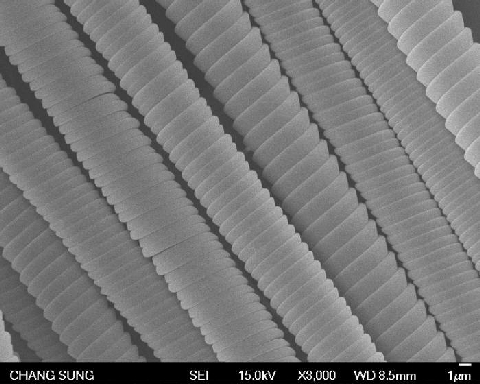Changsung, a metallic materials specialist, successfully developed carbon micro coil (CMC), a new nano carbon material, as the first in Korea. CMC is a next-generation material drawing the world’s attention because of its excellent properties not found in the existing carbon materials. Attempts for development had been made a number of times in Korea. However, none of them was successfully led to commercialization.
According to the industry on the 16th, Changsung recently completed CMC development and embarked on a pilot test for mass-production. The stage of technology development for stable supply of CMC as a practical material has already been completed. Changsung is in the final verification stage for an extensive investment in mass-production.
CMC, which Changsung developed as a new material, is a carbon material developed for the first time by Professor Motojima of Japan’s Gifu University in 1990. After taking over the source technology, Changsung has been striving for commercialization in the last several years.
Characterized with a shape resembling a pigtail rather than a straight line, CMC is an amorphous carbon fiber with a unique structure that is not found in general fiber materials. The biggest strength of CMC is the excellent elasticity. CMC produces ultra high elasticity to stretch for more than ten times of the original coil length. With a unique shape, CMC can be used as an inductor, a key electric circuit component.
In addition, the electrochemical characteristics enable this material to be used widely as an electromagnetic wave absorbent, a hydrogen containing material, a microwave heating material, a tactile proximity sensor and a biological activator. In particular, while existing carbon materials block electromagnetic waves at low frequencies, CMC absorbs electromagnetic waves by 99% or more in a high frequency range of tens of GHz.
However, CMC’s growth speed is slower by ten times than carbon nano tube (CNT). Therefore, it is mostly developed using chemical vapor deposition (CVD) process. Changsung will also set out for CMC mass-production using CVD technique. As ingredients for CMC, hydrocarbon materials, such as acetylene, methane, profane and benzene, can be used.
“Production yield varies widely according to the ingredient used. So, we cannot disclose details of our technology,” said a Changsung insider. “CMC is an extremely attractive material and is expected of application to a wide range of fields in the future.”
Seong Hyeon-hee | sunghh@etnews.com
창성, 국내 첫 카본마이크로코일(CMC) 개발 완료…대규모 양산 체제 준비
금속 소재 전문업체 창성이 나노탄소 신소재 카본마이크로코일(CMC)을 국내 처음 개발하는 데 성공했다. CMC는 기존 탄소 재료에는 없는 우수한 물성 덕분에 많은 세계적으로 관심받고 있는 차세대 소재다. 그동안 국내에서도 여러 차례 개발을 시도했지만 결국 상용화하진 못했다.
16일 업계에 따르면 최근 창성은 CMC 개발을 완료하고 대량 생산을 위한 파일럿 테스트에 돌입했다. 실용 재료로서 안정적으로 공급하기 위한 기술 개발 단계는 이미 끝났고, 대규모 양산 투자에 나서기 위한 막바지 검증단계에 와 있다.
창성이 신소재로 개발한 CMC는 지난 1990년 일본 기후대학교 모토지마 교수에 의해 세계 최초로 개발된 탄소 소재다. 창성은 이들로부터 원천 기술을 이전받아 지난 수년간 상용화를 위해 노력해 왔다.
CMC는 직선 모양이 아닌 돼지 꼬리처럼 말려져 있는 형상이 특징으로, 섬유 소재가 가질 수 없는 독특한 구조를 지닌 비정질 탄소 섬유다. 최대 장점은 우수한 탄력성이다. 원래 코일 길이의 10배 이상이 늘어나는 초탄력성을 보인다. 독특한 형상으로 전기 회로의 핵심 부품인 인덕터처럼 활용할 수도 있다.
또 전기?화학적 특성으로 전자파 흡수재, 수소 흡장재, 마이크로파 발열재, 촉각 근접 센서, 생물 활성화제 등 폭넓은 분야에 활용할 수 있다. 특히 기존 탄소 소재는 낮은 주파수에서 전자파를 차단할 수 있었지만 CMC는 수십 ㎓ 이상의 고주파 영역에서 전자파를 99% 이상 흡수할 수 있다.
그러나 CMC는 탄소나노튜브(CNT)에 비해 성장 속도가 10배가량 늦다. 때문에 대부분 화학기상증착법(CVD) 공정으로 개발한다. 창성도 CVD 방식으로 CMC 대량 생산에 나선다. CMC 원료로는 탄화수소계, 즉 아세틸렌?메탄?프로판?벤젠 등을 모두 사용할 수 있다.
창성 관계자는 “어떤 원료를 쓰는지에 따라 생산 수율에 차이가 많이 나기 때문에 상세한 기술 내용을 밝힐 수는 없다”며 “CMC는 굉장히 매력적인 소재여서 향후 다양한 분야에 널리 활용될 수 있을 것”으로 기대했다.
성현희기자 | sunghh@etnews.com
